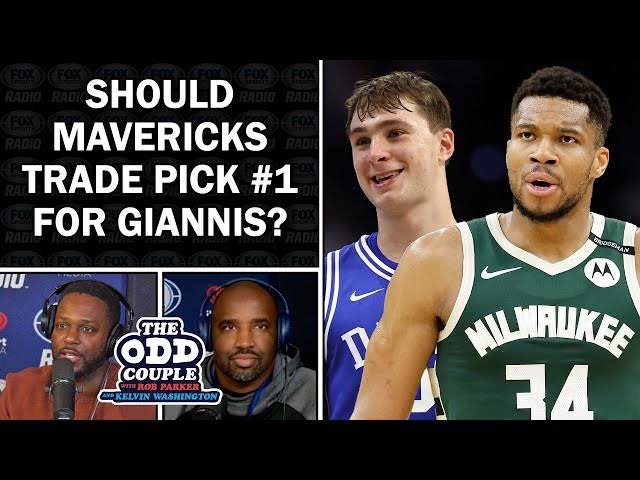Title: “Desperate for Playmaking? Evaluating the Dallas Mavericks’ Trade Options and Their Survival Odds Without One”
After an impressive run to the 2024 NBA Finals, the Dallas Mavericks have proven they’re a legitimate contender. Led by the generational brilliance of Luka Dončić and the clutch shot-making of Kyrie Irving, Dallas muscled its way past Western Conference heavyweights before falling short against a deeper, more balanced Boston Celtics squad. As the 2025 offseason progresses, the question is clear: can the Mavs run it back with the current roster, or is it time to get aggressive on the trade market—particularly for another playmaker?
Let’s break down both paths: surviving without a trade versus exploring the most realistic trade scenarios that could elevate the Mavericks into a championship favorite.
The Case for Standing Pat: Is Internal Growth Enough?
Despite their Finals loss, the Mavericks showed notable growth throughout the 2023–24 season. Key mid-season acquisitions like P.J. Washington and Daniel Gafford shored up the frontcourt, adding athleticism and rim protection that had been missing. Rookie Dereck Lively II also exceeded expectations, offering elite shot-blocking and vertical spacing. However, what remains concerning is the team’s overreliance on Dončić and Irving for all things playmaking.
During the Finals, when either of the two stars sat—or worse, struggled—the offense sputtered. There wasn’t a reliable tertiary creator who could keep the engine humming. Tim Hardaway Jr., Josh Green, and Jaden Hardy had their moments, but none provided consistent shot creation or playmaking under playoff pressure.
So, the argument for standing pat revolves around three ideas:
- Continuity – The Mavs finally have a defined rotation. Let chemistry grow.
- Internal Improvement – Can Josh Green or Jaden Hardy make the leap to become a legitimate third creator?
- Dončić’s Growth as a Leader – Luka’s defense and conditioning improved. If he keeps trending upward, the need for another ballhandler lessens slightly.
Still, these are optimistic assumptions. Banking on internal development—especially with a championship window wide open—might be too risky. This is where trade talk becomes not just an option, but a potential necessity.
The Case for a Trade: Dallas Desperately Needs a Third Playmaker
Kyrie Irving will turn 33 next season, and while he’s still elite offensively, his injury history is a constant variable. Luka Dončić is only 26 but bears one of the heaviest usage rates in the NBA. It’s simply unsustainable for these two to be responsible for all shot creation deep into the playoffs. Against Boston, when their legs wore down, the Mavericks had no plan B.
Enter the trade market.
Top Trade Targets:
1. Malcolm Brogdon (Portland Trail Blazers)
- Fit: Brogdon is a low-maintenance combo guard who can initiate offense, hit threes, and defend his position.
- Cost: Possibly a future first-round pick and salary filler (e.g., Tim Hardaway Jr. or Maxi Kleber).
- Upside: Brogdon wouldn’t need to start but would solidify the second unit and take pressure off Luka/Kyrie.
2. Terry Rozier (Charlotte Hornets)
- Fit: A microwave scorer who can also function as a secondary playmaker.
- Cost: Similar to Brogdon, though Rozier’s contract is longer and more expensive.
- Upside: Rozier brings energy and aggression, something the Mavericks’ bench sorely lacks.
3. Monte Morris (Free Agent / Trade Sign-and-Trade)
- Fit: Low-turnover, high-IQ guard. Not flashy, but dependable.
- Cost: Likely a mid-level exception (MLE) target or could be a throw-in on a larger deal.
- Upside: A stable floor general to run the second unit when Luka rests.
4. Bruce Brown (Toronto Raptors)
- Fit: Not a pure playmaker, but a connective piece who can handle the ball in secondary actions and guard multiple positions.
- Cost: Likely cheaper than some pure guards and more versatile.
- Upside: Defense, hustle, and playoff toughness—perfect for the Mavs’ identity.
Navigating the Cap: Can the Mavs Make a Deal?
The Mavericks are operating near the luxury tax line, which makes big moves challenging but not impossible. They’ll likely explore sign-and-trade scenarios or leverage Hardaway’s expiring contract. One creative avenue could be a multi-team trade involving a rebuilding team offloading veterans for draft capital.
Another option is leveraging the Mid-Level Exception (MLE), which could land a steady veteran like Tyus Jones or Dennis Schröder—both capable of running a second unit and alleviating the star duo’s burden.
Conclusion: No Time to Waste the Window
The Mavericks have two of the most talented guards in the NBA, a promising young big man in Lively, and several capable role players. But without a reliable third playmaker, they remain vulnerable to injury, fatigue, and defensive pressure in tight playoff games.
While standing pat isn’t the worst move, it’s a gamble that places all hope on internal development and health—two things notoriously volatile in the NBA.
The smarter, safer path? Strike now. Add another creator who can steady the offense when Luka or Kyrie sit. Whether that’s Brogdon, Rozier, or a sneaky MLE signing, Dallas must act with urgency. With the Western Conference getting stronger by the year, a marginal upgrade could be the difference between another Finals run or a second-round exit.
The Mavericks don’t just need more talent. They need insurance. Playmaking insurance. And the time to buy it is now.
